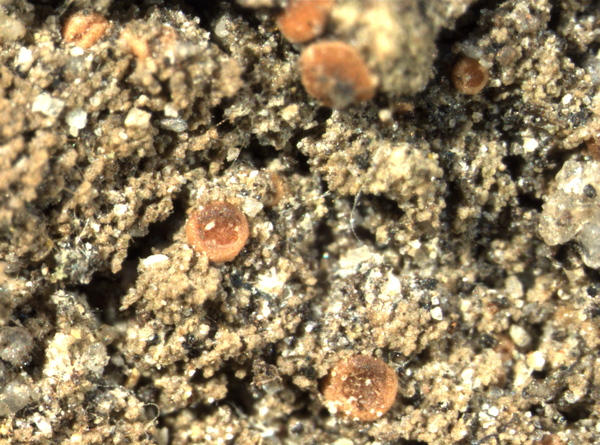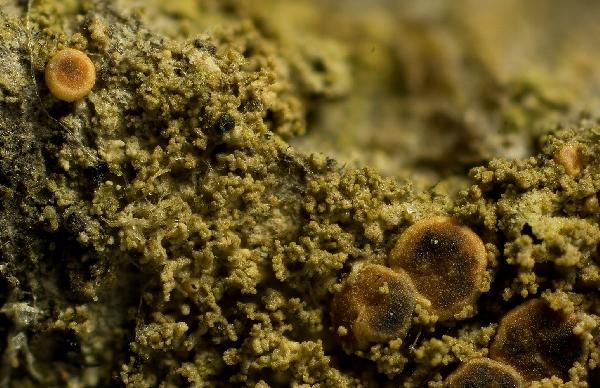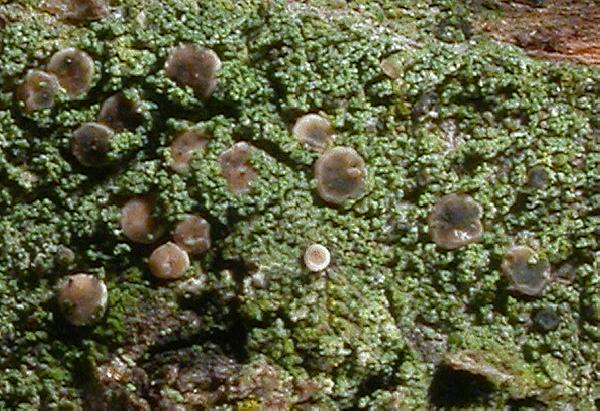Bacidina neosquamulosa (Aptroot & Herk) S. Ekman
Lichen Flora of the Greater Sonoran Desert Region, 2: 31, 2004. Basionym: Bacidia neosquamulosa Aptroot & Herk - Lichenologist, 31: 122, 1999
Synonyms: Bacidina delicata auct. p.p. non (Leight.) V. Wirth & Vězda; Woessia neosquamulosa (Aptroot & Herk) Van den Boom & P. Alvarado
Distribution: N - Ven (Ekman 2023).
Description: Thallus crustose-subsquamulose, episubstratic, greenish grey to olivaceous, dull, corticate, consisting of microsquamules, without a distinct prothallus. Microsquamules deeply incised, crenate, slightly concave to convex, up to 0.4 mm wide, bearing globose, 50-100 μm wide, isidia-like granules mostly along the margins, sometimes over the whole surface; in thalli with poorly developed microsquamules the granules are smaller and form pale soredia. Apothecia frequent, biatorine, round to irregular in outline, 0.2-1 mm across, at first flesh-coloured, than often patchily or entirely blackening, with a flat to convex disc, and a persistent proper margin. Proper exciple well-developed, dark brown in outer part, colourless within, prosoplectenchymatous throughout, but with somewhat expanding lumina towards the periphery and in the lower parts, 50-100 μm wide, the cells 6-12 x 4-8 μm, the pigmented parts K+ purplish, N+ purple-brown, without crystals or granules; epithecium partly hyaline, partly dark brown, the pigmented parts K+ purplish, N+ purple-brown, without crystals; hymenium colourless, 40-55(-60) μm high; paraphyses mostly simple, the apical cells swollen, 3-5 μm wide; hypothecium colourless. Asci 8-spored, clavate to cylindrical-clavate, the apical dome K/I+ dark blue with a pale, conical-pointed apical cushion (axial mass) never penetrating through the entire d-layer, the wall K/I-, but the thin outer gel K/I+ blue, Bacidia-type. Ascospores 3-7-septate, hyaline, needle-like to slightly clavate, coiled in the asci, Bacidia-type, (35-)40-55(-58) x 1.3-1.7 μm. Pycnidia laminal, globose, erumpent, dark in upper part due to an olivaceous-grey pigment reacting K-, N+ purple-red. Macroconidia hyaline, thread-like, curved, 3-7-septate, (35-)40-57 x (1.2-)1.5-2 μm, the proximal end somewhat truncate. Photobiont chlorococcoid. Spot tests: thallus K-, C-, KC-, P-, UV-. Chemistry: thallus without lichen substances.
Note: on trees with subneutral bark in nutrient-rich, dusty situations such as in urban parks and forest edges along secondary dirt roads, very rarely also on nutrient-enriched rocks; widespread in Europe and also recorded from Western North America, with a single record from the Eastern Alps (Austria), but probably more widespread. Part of the type material of Bilimbia arceutinoides Anzi from Veneto belongs to this species (Ekman 2023).
Growth form: Crustose
Substrata: bark
Photobiont: green algae other than Trentepohlia
Reproductive strategy: mainly asexual, by isidia, or isidia-like structures (e.g. schizidia)
Commonnes-rarity: (info)
Alpine belt: absent
Subalpine belt: absent
Oromediterranean belt: absent
Montane belt: absent
Submediterranean belt: very rare
Padanian area: extremely rare
Humid submediterranean belt: absent
Humid mediterranean belt: absent
Dry mediterranean belt: absent
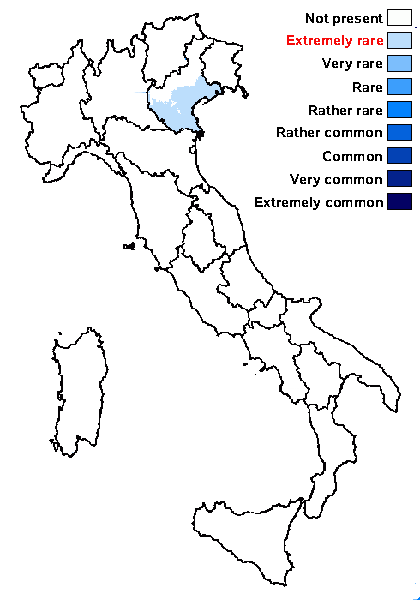
Predictive model
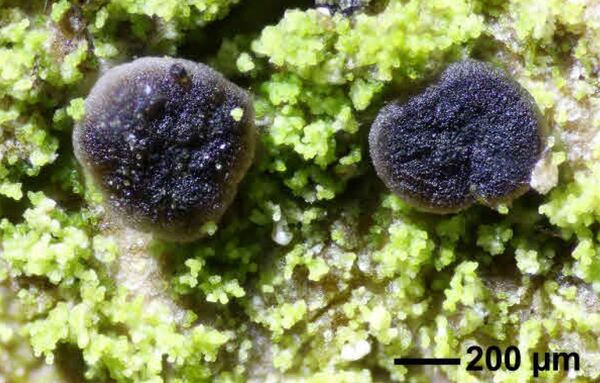

Felix Schumm – CC BY-SA 4.0
[14969], Germany, Baden-Württemberg, Kreis Göppingen, westlich Zachersmühle im Herrenbachtal, auf Esche im Mühlhölzle, ca. 48,74° N, 9,62° E, 359 m, TK 7223. Leg Schumm 24.07.2009, det. Aptroot 2009
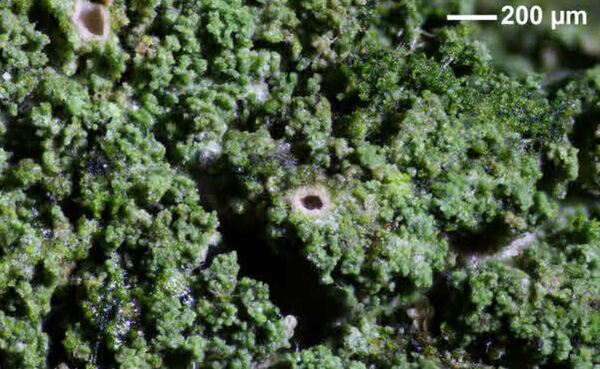

Felix Schumm – CC BY-SA 4.0
[14952], Germany, Baden-Württemberg, Kreis Göppingen, Faurndau Friedof, 48,70390° N, 9,61455° E, 314 m, TK 7223. Leg. Aptroot, Stapper & Schumm 18.09.2009, det. Aptroot 2009.
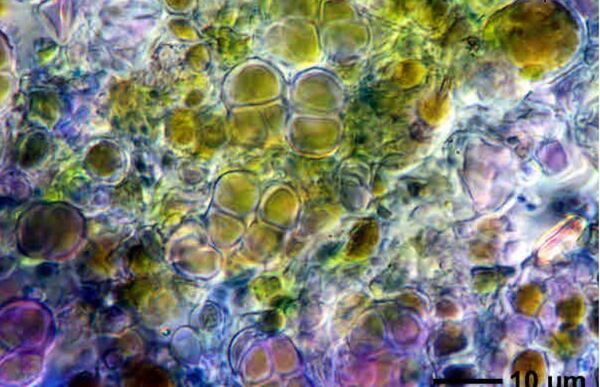

Felix Schumm – CC BY-SA 4.0
[14952], Germany, Baden-Württemberg, Kreis Göppingen, Faurndau Friedof, 48,70390° N, 9,61455° E, 314 m, TK 7223. Leg. Aptroot, Stapper & Schumm 18.09.2009, det. Aptroot 2009.


Felix Schumm – CC BY-SA 4.0
[14952], Germany, Baden-Württemberg, Kreis Göppingen, Faurndau Friedof, 48,70390° N, 9,61455° E, 314 m, TK 7223. Leg. Aptroot, Stapper & Schumm 18.09.2009, det. Aptroot 2009.
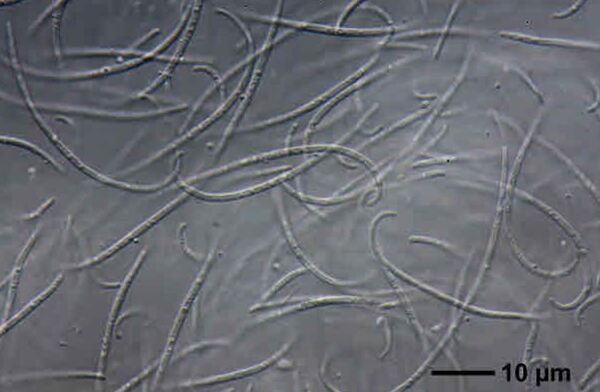

Felix Schumm – CC BY-SA 4.0
[14952], Germany, Baden-Württemberg, Kreis Göppingen, Faurndau Friedof, 48,70390° N, 9,61455° E, 314 m, TK 7223. Leg. Aptroot, Stapper & Schumm 18.09.2009, det. Aptroot 2009.
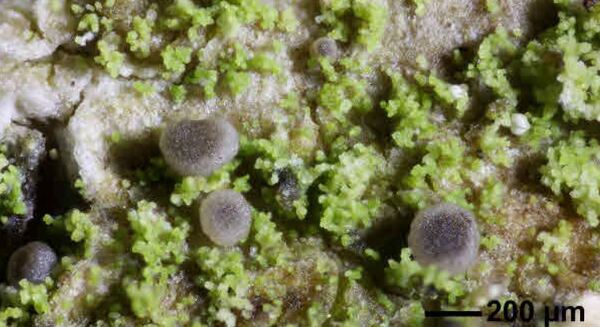

Felix Schumm – CC BY-SA 4.0
[14969], Germany, Baden-Württemberg, Kreis Göppingen, westlich Zachersmühle im Herrenbachtal, auf Esche im Mühlhölzle, ca. 48,74° N, 9,62° E, 359 m, TK 7223. Leg Schumm 24.07.2009, det. Aptroot 2009
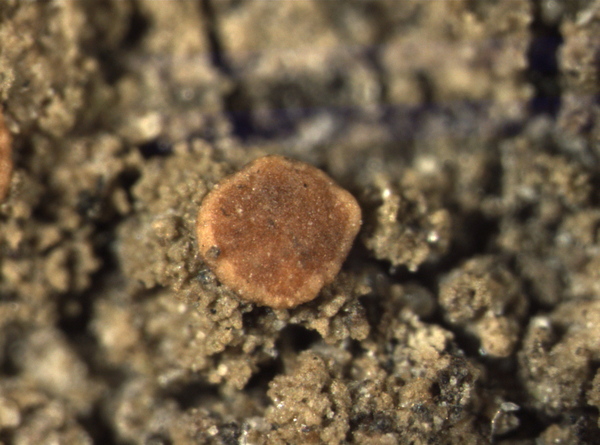

E. Pittao; Owner: Department of Life Sciences, University of Trieste
Herbarium: TSB (TSB 36202)
20.10.2009


Felix Schumm – CC BY-SA 4.0
[14969], Germany, Baden-Württemberg, Kreis Göppingen, westlich Zachersmühle im Herrenbachtal, auf Esche im Mühlhölzle, ca. 48,74° N, 9,62° E, 359 m, TK 7223. Leg Schumm 24.07.2009, det. Aptroot 2009


Felix Schumm – CC BY-SA 4.0
[14969], Germany, Baden-Württemberg, Kreis Göppingen, westlich Zachersmühle im Herrenbachtal, auf Esche im Mühlhölzle, ca. 48,74° N, 9,62° E, 359 m, TK 7223. Leg Schumm 24.07.2009, det. Aptroot 2009


Felix Schumm – CC BY-SA 4.0
[14969], Germany, Baden-Württemberg, Kreis Göppingen, westlich Zachersmühle im Herrenbachtal, auf Esche im Mühlhölzle, ca. 48,74° N, 9,62° E, 359 m, TK 7223. Leg Schumm 24.07.2009, det. Aptroot 2009


Felix Schumm – CC BY-SA 4.0
[14969], Germany, Baden-Württemberg, Kreis Göppingen, westlich Zachersmühle im Herrenbachtal, auf Esche im Mühlhölzle, ca. 48,74° N, 9,62° E, 359 m, TK 7223. Leg Schumm 24.07.2009, det. Aptroot 2009
Growth form: Crustose
Substrata: bark
Photobiont: green algae other than Trentepohlia
Reproductive strategy: mainly asexual, by isidia, or isidia-like structures (e.g. schizidia)
Commonnes-rarity: (info)
Alpine belt: absent
Subalpine belt: absent
Oromediterranean belt: absent
Montane belt: absent
Submediterranean belt: very rare
Padanian area: extremely rare
Humid submediterranean belt: absent
Humid mediterranean belt: absent
Dry mediterranean belt: absent

Predictive model


Felix Schumm – CC BY-SA 4.0
[14969], Germany, Baden-Württemberg, Kreis Göppingen, westlich Zachersmühle im Herrenbachtal, auf Esche im Mühlhölzle, ca. 48,74° N, 9,62° E, 359 m, TK 7223. Leg Schumm 24.07.2009, det. Aptroot 2009


Felix Schumm – CC BY-SA 4.0
[14952], Germany, Baden-Württemberg, Kreis Göppingen, Faurndau Friedof, 48,70390° N, 9,61455° E, 314 m, TK 7223. Leg. Aptroot, Stapper & Schumm 18.09.2009, det. Aptroot 2009.


Felix Schumm – CC BY-SA 4.0
[14952], Germany, Baden-Württemberg, Kreis Göppingen, Faurndau Friedof, 48,70390° N, 9,61455° E, 314 m, TK 7223. Leg. Aptroot, Stapper & Schumm 18.09.2009, det. Aptroot 2009.


Felix Schumm – CC BY-SA 4.0
[14952], Germany, Baden-Württemberg, Kreis Göppingen, Faurndau Friedof, 48,70390° N, 9,61455° E, 314 m, TK 7223. Leg. Aptroot, Stapper & Schumm 18.09.2009, det. Aptroot 2009.


Felix Schumm – CC BY-SA 4.0
[14952], Germany, Baden-Württemberg, Kreis Göppingen, Faurndau Friedof, 48,70390° N, 9,61455° E, 314 m, TK 7223. Leg. Aptroot, Stapper & Schumm 18.09.2009, det. Aptroot 2009.


Felix Schumm – CC BY-SA 4.0
[14969], Germany, Baden-Württemberg, Kreis Göppingen, westlich Zachersmühle im Herrenbachtal, auf Esche im Mühlhölzle, ca. 48,74° N, 9,62° E, 359 m, TK 7223. Leg Schumm 24.07.2009, det. Aptroot 2009


E. Pittao; Owner: Department of Life Sciences, University of Trieste
Herbarium: TSB (TSB 36202)
20.10.2009


Felix Schumm – CC BY-SA 4.0
[14969], Germany, Baden-Württemberg, Kreis Göppingen, westlich Zachersmühle im Herrenbachtal, auf Esche im Mühlhölzle, ca. 48,74° N, 9,62° E, 359 m, TK 7223. Leg Schumm 24.07.2009, det. Aptroot 2009


Felix Schumm – CC BY-SA 4.0
[14969], Germany, Baden-Württemberg, Kreis Göppingen, westlich Zachersmühle im Herrenbachtal, auf Esche im Mühlhölzle, ca. 48,74° N, 9,62° E, 359 m, TK 7223. Leg Schumm 24.07.2009, det. Aptroot 2009


Felix Schumm – CC BY-SA 4.0
[14969], Germany, Baden-Württemberg, Kreis Göppingen, westlich Zachersmühle im Herrenbachtal, auf Esche im Mühlhölzle, ca. 48,74° N, 9,62° E, 359 m, TK 7223. Leg Schumm 24.07.2009, det. Aptroot 2009


 Index Fungorum
Index Fungorum
 GBIF
GBIF
